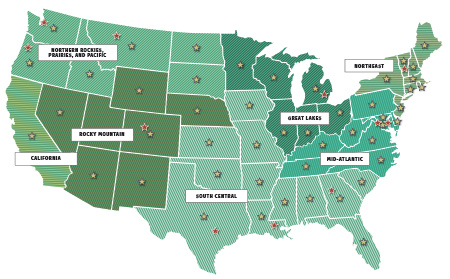The National Wildlife Federation is leading Downstream, a project built to better understand the factors impacting farmers' decision-making and train conservation outreach professionals on strategies to engage farmers in adopting more resilient practices.
As the world’s largest reserve of fresh water, the Great Lakes stand as a vital natural resource to millions of residents who live along their shores, depending upon them for drinking water and recreation. They also provide a significant economic engine to many of those same communities. Yet the health of the Great Lakes continues to be imperiled by pollution from a number of sources, the primary source being agricultural lands.
Historically excessive fertilizer and soil amendment applications, over-reliance on tillage to prepare fields and manage weeds, and the loss of diverse crop rotations have resulted in decreased capacity of farm fields to hold nutrients. Increasingly those fertilizers are sent down river to the Great Lakes, where they feed algae growth, degrading water quality while significantly raising the costs to water utilities and customers.
Solutions in agriculture exist, which farmers can implement to reduce pollution to the Great Lakes while building productivity and resiliency. One of these solutions is cover crops—crops grown not for harvest, but to hold onto nutrients for the next crop, reduce weeds, improve soil structure, and build the health and productive capacity of the soil. Despite these benefits, cover crop use remains relatively low (less than 10%) among Great Lakes farmers.
One of the main challenges farmers face when implementing cover crops is the significant social ramifications. Challenging traditional methods is difficult in any profession. In farming, that challenge is compounded by two unique realities. First, farming practices are made visible for all to observe and critique. Because of this reality, farmers who implement practices that look different from traditional fallow tillage methods, such as cover crops or no-till (planting crops and managing crop residue without the use of tillage), inherently put themselves in a position to receive criticism from those who continue to use old farming methods. Second, because of the unique dependence upon weather, farming faces much higher risk and uncertainty than any other occupation. That risk and uncertainty fundamentally changes the decision-making dynamic in which members of a group feel safer (but may actually be less safe) by conforming to a group through perpetuating traditional practices popular with the majority of producers in an area. Until these fundamental challenges get addressed, widespread adoption of soil health practices that can save the Great Lakes will never occur.
The “Strategies to Engage Middle Adopter Farmers on Cover Crops” project seeks to take on this monumental challenge. By understanding farmer decision-making and all of the factors that influence the process, this project seeks to equip conservation outreach professionals across the Great Lakes region and beyond. The effort includes the development of outreach methods and messaging strategies to address important social components and dramatically increase success in convincing the majority of farmers to adopt cover crops, no-till, and diverse crop rotations that provide benefits to farmers, wildlife, and the Great Lakes.
Through this multi-year project we have found that just providing information on conservation practices to farmers has not resulted in widespread adoption of these practices. Instead, framing new practices in terms of the problems they will help solve and contextualizing them is more successful. Farmers need to hear about the need to change current practices from multiple angles that meet all their values, including conservation. We continue to work with outreach specialist and researchers on developing messaging materials for wider distribution as we conclude this project.
A new storymap connects the dots between extreme weather and climate change and illustrates the harm these disasters inflict on communities and wildlife.
Learn MoreTake the Clean Earth Challenge and help make the planet a happier, healthier place.
Learn MoreA groundbreaking bipartisan bill aims to address the looming wildlife crisis before it's too late, while creating sorely needed jobs.
Read MoreMore than one-third of U.S. fish and wildlife species are at risk of extinction in the coming decades. We're on the ground in seven regions across the country, collaborating with 52 state and territory affiliates to reverse the crisis and ensure wildlife thrive.
